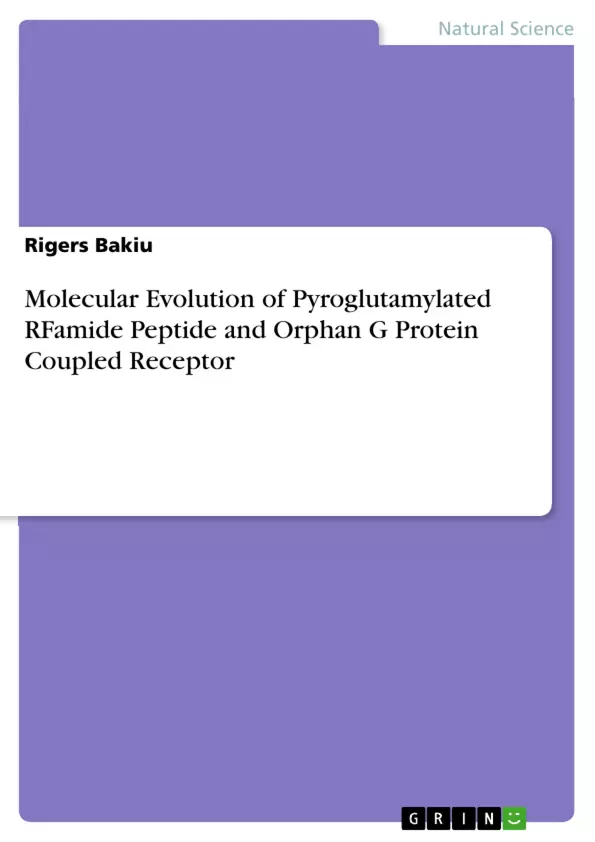G protein-coupled receptors (GPCRs) are members of a large protein family that share common structural motifs, including seven transmembrane helices, and play pivotal roles in cell-to-cell communications and in the regulation of cell functions. GPR103 is an orphan GPCR that shows similarities with orexin, neuropeptide FF, and cholecystokinin receptors.
In humans, 26RFa/QRFP has been found to be an endogenous ligand for the orphan receptor, GPR103 and it is one of the RFamide peptides, which have been shown to exert important neuroendocrine, behavioural, sensory and autonomic functions.
All the information we have till know couldn’ be available if we didn’t know the evolution of this important proteins and the relative interactions, which were discovered recently to be important for the regulation of locomotor activity, sleep and these neuropeptides and receptors exert neuroprotective effect in Alzheimer’s Disease.
Anyway, there is a long way to be walked on, because there is a need of additional information, while studing the molecular evolution of these proteins and peptides.
What is the Molecular Evolution?
In the First chapter the readers can find all about this branch of science and the problems this branch had overcomed in order to bring to the scientific community the molecularisation of the evolution concepts.
In the following chapter to the readers is presented a descriptive overview of G-proteins and G-protein coupled receptor.
In the other chapters it is also presented 26RFA/QRFP and pyroglutamylated RFamide peptide receptor (QRFPR) molecular evolution, where it is described the molecular phylogeny and the functional implication. It is even shown the unique study regarding the presence on natural selection (positive or negative selection) during the evolution of QRFPRs in mammals and fish species.
In the end of the book are shown the recent important finding regarding the function and the role of QRFP and its receptor, together with the experimental approach applied to zebrafish and rodents.
Anyway, it is imperative to mention that all the available knowledge from experiments to these animals can be useful for the curation of disorders and other deseases like Alzheimer’s Disease, only if we could understand well their molecular evolution.
Inhaltsverzeichnis (Table of Contents)
- G PROTEIN COUPLED RECEPTORS
- G-PROTEINS
- RFAMIDE NEUROPEPTIDE FAMILY AND 26-AMINO ACID RESIDUE RFAMIDE PEPTIDE (26RFA/QRFP)
- PYROGLUTAMYLATED RFAMIDE PEPTIDE RECEPTOR
- SURPRISES FROM THE FASCINATING RESEARCH ON QRFP AND ITS RECEPTORS
- CONCLUSIONS AND FUTURE DIRECTIONS
Zielsetzung und Themenschwerpunkte (Objectives and Key Themes)
This monograph aims to provide a comprehensive exploration of the molecular evolution of pyroglutamylated RFamide peptide and its orphan G protein coupled receptor (GPR103). The work delves into the evolutionary history of these molecules, highlighting their significance in various biological processes.
- The molecular evolution of G protein-coupled receptors (GPCRs) and G-proteins.
- The evolutionary history of the RFamide neuropeptide family, specifically focusing on the 26-amino acid residue RFamide peptide (26RFA/QRFP).
- The molecular evolution of the pyroglutamylated RFamide peptide receptor (QRFPR) and its functional implications.
- The role of natural selection in the evolution of QRFPRs across different species.
- The recent findings regarding the function and role of QRFP and its receptor in regulating biological processes.
Zusammenfassung der Kapitel (Chapter Summaries)
- Introduction: This chapter introduces the concept of molecular evolution, outlining its importance in understanding the diversity of life on Earth. It also discusses the historical development of molecular biology and its impact on the study of evolution.
- G PROTEIN COUPLED RECEPTORS: This chapter provides a detailed overview of G protein-coupled receptors (GPCRs), their structure, and their essential roles in cell signaling and communication.
- G-PROTEINS: This chapter focuses on G-proteins, their structure, and their interaction with GPCRs in mediating cellular responses to various stimuli.
- RFAMIDE NEUROPEPTIDE FAMILY AND 26-AMINO ACID RESIDUE RFAMIDE PEPTIDE (26RFA/QRFP): This chapter explores the RFamide neuropeptide family, highlighting the 26-amino acid residue RFamide peptide (26RFA/QRFP) and its involvement in neuroendocrine and behavioral functions.
- PYROGLUTAMYLATED RFAMIDE PEPTIDE RECEPTOR: This chapter delves into the molecular evolution of the pyroglutamylated RFamide peptide receptor (QRFPR), examining its phylogeny and functional implications. It also analyzes the impact of natural selection on its evolution.
Schlüsselwörter (Keywords)
The key terms and concepts explored in this monograph include molecular evolution, G protein-coupled receptors (GPCRs), G-proteins, RFamide peptides, 26RFA/QRFP, pyroglutamylated RFamide peptide receptor (QRFPR), phylogeny, natural selection, functional implications, neuroendocrine function, behavioral function, and the role of QRFP and its receptor in biological processes.
- Citation du texte
- Associate Professor Rigers Bakiu (Auteur), 2016, Molecular Evolution of Pyroglutamylated RFamide Peptide and Orphan G Protein Coupled Receptor, Munich, GRIN Verlag, https://www.grin.com/document/347085



